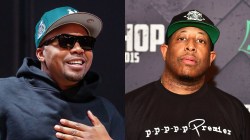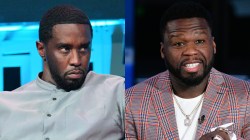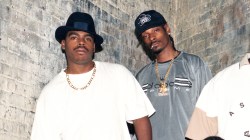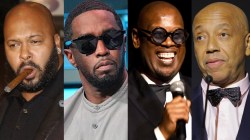Hip Hop’s support of protest regarding the North Dakota Access Pipeline hasn’t gone without notice. Before recent events became a news cycle trending topic, Pharrell showed support by making a plea to his more than 10 million Facebook fans. More recently, nearly a dozen local artists from Chicago threw a benefit concert for the Oceti Sakowin Camp including SamIAm and Tewz. In November, both Vic Mensa and Hollow Da Don spent time in Standing Rock protesting as well. For many, the latest events are just another chapter in the long and brutal battle Native Americans have fought against white supremacy. Obviously, this is something that anyone who has followed Hip Hop culture can relate to.
However, there’s one odd thing about all of this.
Hip Hop culture has historically found inspiration from Native American aesthetics, but there has yet to be a large enough mainstream rapper speaking specifically to that struggle. Looking at the mainstream rap press, they never existed.
After some digging around in a search of someone with a real understanding of everything going on, it was clear HipHopDX had to get Litefoot on the phone.
More known for his life as an actor with roles in everything from Mortal Kombat: Annihilation and Adaptation to House of Cards, the Tulsa, Oklahoma-raised emcee got his start rocking the mic going as far back as his 1992 debut The Money EP. Since then, he’s continued to release more than a dozen projects through his own label Red Vinyl Records. While the rest of Hip Hop focused on major hubs, Litefoot was getting it in without much notice. And, he had a lot of land to cover considering there are 326 reservations within the United States. Let him tell it, he’s responsible for introducing Hip Hop to a lot of them. Russell Simmons once called Red Vinyl Records the Def Jam equivalent in Indian Country.
Not only did Litefoot make some serious money tapping into an untapped market, but supported serious initiatives to improve his community. In September, he was even given the role as executive director of the Native American Financial Services Association.
During our conversation, the Good Day to Die rapper took the time to speak on a number of topics including his own history as a rapper/actor, cultural appreciation of Native Americans within Hip Hop and why it’s problematic alongside the highly debated North Dakota Access Pipeline.
Litefoot Wanted To Provide A Voice For American Indian Issues
HipHopDX: Kicking things off, I would like to thank you for taking out the time to speak with me. I had only really known about your acting career before diving deep into your pretty heavy catalog of music. You’re still putting out music, which puts your time in the game at around two decades. How exactly did you do it without much notice from mainstream rap media?
Litefoot: Well, the music started back in Tulsa, Oklahoma and it came with me wanting to provide a voice for American Indian issues. When I went and looked, I couldn’t find it anywhere. I couldn’t see us represented anywhere close to where we should be represented. I wanted to try to do my part and looking back, I was standing at the bottom of the mountain looking up. I believed where there was a will, there was a way. I was going to make a difference, it was just going to be that. I was going to have to make a difference. How was I going to go at this music thing? I was going to get my music across through a lot of blood, sweat, tears and passion. I found people that believed in me and just refused to quit and give up. I started that fight and it led to many things. Even today, people think I got into movies and then I started rapping. It’s not that way. It was the music first and then that led me to movies because I performed in 1994 in Rome with the American Indian College Fund and I represented the contemporary aspect of Native American music. I performed at a museum there. It was a really big thing. It went over really well.
When I got back, Paramount Pictures called the American Indian College Fund and asked if they knew any Native American actors. They said that there weren’t any drama departments at the tribal colleges and they brought my name up. That’s exactly where the acting thing took off. I was hot on the reservation in Burns, Oregon. I got a phone call at our office and I had some people I had hired. My dad was working with me at the time. He called me, said that Paramount Pictures called and I thought he was messing with me. We were grinding and on the road touring. At that time, I was driving 15 hours a day from one show to the next show from places like Montana to Arizona, Arizona to California and California to Minnesota. It just wasn’t on my radar to get into acting, but ultimately, everything in my life was about making a difference. I was just trying to help move the needle in Indian Country and bring about awareness and change. I wanted to build bridges and bring people together. Sometimes, that message is pretty straight forward and it is what it is. You have to know what you’re doing and know what you’re about because sometimes you gotta stand alone.
DX: I was listening to your Good Day To Die album and on the “My Land” track there’s a line where you say “Run! Indian head for the mountains / If Colonel Custer comes around then you scalp him / And fly another arrow with the flame on the tip / Flip the cap back, now Mr. C’s on the dead tip.” That was some pretty gangsta-ass shit. What exactly were some of your rap influences at the time?
Litefoot: I really have to say that writing is something that came to me first and before there was the thought of me rapping, I was always into Hip Hop. It was my go-to music. I also grew up on that Motown sound. When it came to my parents, as much as we had that traditional and cultural aspect of who we were growing up, there was also Barry White being played along with The Four Tops, Spinners and Temptations. It was natural for me to get into music. My mom would have people come over for me to dance like Micheal Jackson for them. I just felt the music. I didn’t put it together till a lot later on in life. Really, the writing thing came easy for me. I wanted to say something powerful and that mostly came out for girlfriends I was writing for in high school. I give it up to my sister who was always pursuing music and the one trying to make a record. She asked me to come into the studio in California after my mom moved out there. There were these two producers in this small studio. The track was like a New Jack Swing type of song that sounded something like Guy. I wrote the rap and they asked me to rap it for whoever would possibly rap over it when they got a rapper. It was the first time I had got into the both. I did it and it was wow. I remember putting those headphones on with the mic and I felt like I was at home. That’s what got me.
Then I started putting all my thoughts toward the music I wanted to make. I was influenced from Afrika Bambaataa and Kool Moe D to Public Enemy. These were people I saw standing up. One of the people I remember listening to rolling around in Oklahoma was Kid Frost’s “La Raza.” I heard him say that line “It’s in my blood to be an Aztec Warrior / Go to any extreme and hold no barriers” and it was the first time I had heard anyone rap about being a Native ever in Hip Hop. I saw folks that were wearing headdresses like Kool Herc and all those guys dressing up like American Indians. I remember Apache, all those B-Boys and people of the movement. I kind of felt like I was glad for them representing, but at the same time it was disrespectful. You ain’t going to see me put on a bunch of Zulu stuff and going around. So, like it’s crazy how people don’t get it sometimes. I even looked at T.I.’s stuff with the American Indian with the headdress on wearing it around. Like, where’s the balance man? If you’re going to do it and do it out of respect, do something to bring enlightenment to what the struggle is. How would they feel if it was the other way around and I was wearing some black man on my shirt? They wouldn’t give me a pass. It’s crazy, but we don’t see it.
DX: It’s almost similar to the complaint many have about American football and baseball teams.
Litefoot: The whole mascot thing. A lot of people ask if there are more important issues than that. I get where they’re coming from because they’re absolutely right. We have young men on the reservation taking their life every single day. We have the highest rate of suicide and the lowest graduation rate. We have issues in poverty, housing and healthcare. You just go down the list. The mascot thing probably has to be at the bottom of the list, but at the end of the day, I don’t really agree with that. Here’s why. When you reduce somebody down to a cartoon or desensitize who they are to a logo or depiction that you can make up and sort of water it down to whatever you’re comfortable with. It becomes your sort of understanding of who they are. If you don’t know anything more than that, how are you ever suppose to understand or become a partner and help beyond that? I think that’s where you get into big issues because you can dumb people down to who people are and control the narrative as to what they are as a stereotype. You have literally created intellectual genocide against a people.
DX: I totally get that. I guess that’s how oppression works right?
Litefoot: What can we do to lift each other up and come together?
Litefoot Explains His Role In Bringing Hip Hop To Reservations & Doing Well For Himself Financially
DX: That’s a good question. I know you’ve been essentially lifting people by grinding on the independent level for around 20 years. How were you and your label Red Vinyl Records able to survive without being mainstream commercially or even mainstream in underground circles?
Litefoot: Let me not start crying on this man. It was tough man. It was tough. I’ve been in it since it was two inch tapes and $250 an hour studio time. Everything about the music business was tough as an independent. I was independent, independent. I just realized that no one was coming to help me. Ain’t nobody coming to rescue me. Ain’t nobody coming to save me. If I’m going to make this thing happen, I gotta buckle down and be serious about it and passionate about it. I gotta find my own lane. That came through asking myself what I was doing this for. Where was I trying to take this message? I wanted to take it out into my community and everywhere else in-between. If I’m going to do this with my music, who am I trying to reach? Where am I trying to make a difference? To me, I saw every one of those battlegrounds out on reservations or Native Indian communities across North America. It’s different because I hear people slangin’ mixtapes out their trunks and trying to push units in the streets. That’s great if you’re from the Bronx or Compton, but our hood from the Pacific Ocean to the Atlantic Ocean in little spots all over the place. I had to go out and go get it man. Me standing on the block meant driving 12 hours to the next reservation, showing people what it’s about and letting them see me in places where Hip Hop has never been to before.
Literally, I would go to schools and start rapping and people would start looking at their friends like what’s that. It would take two or three songs before they got it and then it was on after that. It was literally Showtime At The Apollo at every single concert. You develop a whole lot of skills and talents just out of sheer necessity when you’re literally baptized by fire every single time you go on stage. It hardens your resolve and makes you believe in what you’re doing more than anything else can make you believe in that. It’s not just the music, it’s a way of life. This is what I’m about and this is who I am. I’m just going to do it. No questions asked. Quitting isn’t an option. Then, you got the other side to it. To get from one reservation to the next is gas money. I had folks who came to perform with me. We had to buy equipment because they didn’t have that kind of equipment anywhere close to a reservation. We had to learn how to set up the music, equipment and speakers. All of this stuff and then we had to do the show. We had to sign autographs and become smart enough to understand merchandise because we had to give something they could believe in.
When we’re gone, we needed them to wear our shirts and listen to the music because there wasn’t an iTunes or digital anything. If we’re going to be somewhere, we had to make it last. We had to make the impact so big, people were talking about it for weeks and weeks until we could get back there again. That’s what I did man. I really think because it was done for the right reasons because the creator loves me. I give it all to the creator. I work hard man, but if it wasn’t for the creator. I wanted to play as much as I could play and run as far as I could run. I wanted to do everything in my power to 100 percent. The creator just took it from there. When I went to Rome, there was no way I thought movies would ever be something I was doing. Speaking things into the existence and laws of attraction is about tapping into power, you really start to understand how this works by implementation and doing it. I would be a fool to say it was all me.
DX: One of the things I noticed was a couple of your albums including The Life And Times, Rez Affiliated and The Best Of Mr. Foot were done by Pen & Pixel, who have done some fairly legendary cover art.
Litefoot: I’m telling you, man, we were trying to do it as big as anybody else. People look back at those covers now like wow, but that was in at the time. I found out who was doing it and I literally went down to Texas. I sat down and did the photoshoot at Pen & Pixel and had those guys do four or five records. I mean Chris Rock had a Pen & Pixel cover. Master P was killing it with them and every No Limit record cover had art done by Pen & Pixel. I just wanted to make sure we were providing music to the reservations for the Native American Hip Hop heads that were at the same level as everyone else. I didn’t want them looking down their nose on us. I wanted people to understand we were doing it on the same level as big time independents with huge independent deals. All of my movie money, I would invest back into the music. I would invest back into touring. I would invest back into merch. I used those movies to capitalize within the community.
DX: I’m going to be frank when I ask this. You don’t have to get too deep into the economics, but how much money did your movement take in over the years? A while back you mentioned having employees.
Litefoot: [Laughter] We do very well. It does well for us. I had signed artist and everything. When we were on tour, we had staff and all that kind of stuff. We’ve always been family owned and operated. That’s something I pride myself on because anyone who has worked with family knows it’s a whole extra layer of difficult because you’re working with your family. But, it’s also the most rewarding if you can make it happen. I gotta go back to my wife. She has been the best business partner and the best person I can ever have around me. She booked all the tours and takes care of all the merchandising. We work together on it and she goes and does what she does to get it where it needs to be. I don’t want to duck the question, but at the end of the day, we do well. I realize that being independent without a middleman and finding a way to get the music to the audience, especially now with digital sales.
It’s a beautiful time for an independent artist. If you got the talent and real hot stuff, you should be out there letting the world know about it. I came to the fact that there was a real value, not only in the monetary standpoint, in the creation of your followers or fans. Nothing beats getting in front of your fans and letting them support you and giving them the means to do it. From back in the day with order forms and CDs and selling merch at the shows to touring. I’ve always been on that merch hustle. That really helped when CDs and albums were sort of the reason to go do everything. The people loved the performance and interaction. Today with music not being what it use to be in sales, we’ve been ahead of that game for a long time. People are just making records now to keep touring and stuff like that.
Litefoot On North Dakota Access Pipeline, Donald Trump & Upcoming Music
DX: Native Americans have been peppered throughout Hip Hop lightly. However, there’s never been one to actually come from a reservation and have significant rap recognition. Why is that?
Litefoot: It ain’t over yet. Believe me, I’m still here in the bushes looking around. Let that be the proof of how complicated it is as a Native American artist, Native American doctor, Native American business person or Native American anything. Try to help other people see you for who you are and the talent you’ve been put on this earth to do which you acquired through hard work and people don’t see us that way. That’s why I go back to the whole mascot issue. People see us as that image that everyone has become accustomed to or comfortable with and they don’t know anything else. They don’t know anything besides that. The narrative that has been put forth isn’t our narrative. So, I think that it’s hard for them to go from, “oh you’re a Native rapper’ to ‘Oh, I totally understand that. Let me pour a million dollars into you.” They’re like “Why aren’t you in a headdress?” They’ll ask “Why aren’t you in a tipi?” They’re like “Why do you want to rap? You don’t do this.” It’s not just entertainment. We’re still living in an age where Johnny Depp played Tonto in The Lone Ranger which came out three years ago. How long has it been since white people have played black people through blackface? We still got that bro. That’s where we’re at.
People out there reading this can’t say because it’s like this in the Hispanic community and there’s this much awareness or the same in the African American or Asian community, it must be that way in the Native Indian community as well. No, not even close. It’s ignorant how far behind things are and I think when you really break it down and look at it, our people has been traumatized because we were at war. They screwed us good. They told us we’re going to take your ass and you’re going to remember what y’all did for standing up. If you ever think about standing up again, you’re going to think twice. We still got people afraid to stand up. Rightfully so, this ain’t over. I hope it comes to a place where it’s understood that we can all do more together. That whole pick and choose rhetoric where we’ll say one thing about a community but nothing another community and we kind of believe if we do a little bit, then it’s good enough. Naw man, it’s not good enough. I just think it’s about education and showing up and speaking up. I’m not trying to be a sensationalist or create disruption. I just want people to grow from this, to try to move forward and grow with other brothers and sisters out there across many different communities.
DX: How do you feel about prominent artists in Hip Hop like Pharrell showing support for the North Dakota Pipeline Protest?
Litefoot: First of all, I think Pharrell had to do it to save face from the headdress vibe ignorance that he did some years back through the Elle Magazine cover. He was appropriating something that was significant and special to many tribes and threw it on to stay fashionable. Once again, I don’t think he did that to purposefully hurt anyone. I don’t think he’s that kind of dude, but he still did it. For the moment, probably to his credit, he found a way to come to terms with it and learn. I got to give him respect for that side of it because he didn’t have to do that. He didn’t have to put himself out in the community and do that. I think he is an example of how a wrong can be made right. As important as this issue is and as much as I’ve done in my own career to try to bring awareness of the importance of water, before the North Dakota Access Pipeline, there are many issues in Indian Country right now as important as this issue. I think that what happened is that you get people who don’t completely understand all these issues who don’t have access to information helping them get up to speed on what’s going or don’t know where to look. They look at this issues and they think it’s a one off. I’ve been going to Standing Rock for 20-plus years and gotten so much love from the people there, but I think we have to pay attention to the bigger picture. One of the questions I’ve asked with the whole issue here, what’s the bigger 30,000-foot view?
Right now, we’re starting to see people get eviction notices, we’re starting to see way more law enforcement action than we’ve seen in any other times during this protest and I think that’s going to escalate. What that says to Indian Country is that we have a whole lot of work to do. We have to create a bridge of understanding of what sovereignty is, what treaty obligations are, about who has responsibilities in that and why it’s a problem. I think from my perspective, even though the pipeline doesn’t go directly through reservation land, all of those farmers and people living on that land right now at one point in time, the land of those people. You can’t say today just because the boundaries of the reservation, which Native Americans didn’t create and was created out of agreements with the federal government who told us what we could have, somehow in that negotiation, you have people 100 or 200 years later say that’s not our treaty land. Hold on a minute, you guys were talking about treaties and sectioning off the land. That doesn’t mean that people weren’t buried on whoever’s land. That’s where my people were buried on and you just can’t run a pipeline through there and disrupt their resting place. Go around it or reroute it. Don’t blow something up cause you don’t understand the history of what has happened here. I go back to people reclaiming control of the narrative. Until we do that, unfortunately, more stuff like this is going to happen.
Ignorance is bliss and when people don’t know the facts and information, then they make it up or go with whatever they think they know. That’s dangerous. We have a responsibility to get out there and not just talk about the problems, but the solutions. How are we going to fix it? If there is something that we can find that builds a better future for our children and better day for Indian Country, then we have to be about solutions. My fear is that this pipeline is going to be built anyway … and all of the people that camp there and support it isn’t going to amount to anything. What are we going to do with that energy and people who literally quit their job to move there to support the movement? What is that going to say to them when they really understand the playing field. When they really understand no matter if the world says it isn’t right, they can still do whatever they want? The chairmen of the tribe there is an amazing man. He’s a friend of mine. His sister was the second person appointed to President Obama’s cabinet through The Office of Public Engagement for the internal affairs for Indian Country I believe. You can’t get any much closer to the president. Even with that, he hasn’t said two things about how he would fix it. What does that really say? You can have people all the way to The White House and it ain’t making a difference. When you look at Congress, how many Native Americans do you see? Our problems need to be truly represented. Let’s look at other groups and look at Congress or The Supreme Court. At least there’s an opportunity for them to stand up. I think we have two people in Congress who are Native American to some sort of degree.
https://www.youtube.com/watch?v=KKYg3x7nkZc
DX: All of this is happening with the protest as Trump comes into office. Much has been spoken about the effects of his upcoming presidency on women, African-Americans as well as Hispanics. What does this mean for Native Americans?
Litefoot: I hope that Trump becoming president will not be a return to the days of cutting and slashing Native American support in DC. I hope that it won’t send sovereignty backward. I hope that the gains we’ve made over the years won’t be set back. I hope that we can find ways to build bridges and secure and maintain self-determination for Indian Country. I will say that in my efforts to push economic development in Indian Country and attempting to advance business in Indian Country, I think that they’ll be challenges. We have to find ways to tactically and strategically move forward. We don’t have a choice. We can’t afford to go backward. We have to stop ostracizing each other whether it’s ethnicity or political leaning. We really have to look at how we can move together. If we’re not getting that done, we have to look at our methodology.
DX: Before we wrap this up, DX recently posted the “Native Tongue” track from your SoundCloud page. It’s quite a banger. What should we expect from you musically in the future?
Litefoot: The new album is going to be called Redvolutionary and it’ll be out in the spring of 2017. I’m right now just working with producers to get the tracks right and believe me, the lyrics are already starting to come to me. I just can’t wait to start recording and then we’ll follow up with a tour next year. I think there’ll be something musically for everyone to associate with. I think if I remember back to the first time someone told me about music and coming to my own music and going about it, they said what’s personal was universal. I’m getting personal on it. I think somewhere in that, someone is going to find something for many things they can identify with. Hopefully, we can build those bridges and bring them together because we are more alike than we are apart.
![Method Man Admits He Didn't Like Drake's "Wu-Tang Forever": "I [Wasn't] Getting On That"](https://hiphopdx.com/wp-content/uploads/2025/12/method-man-drake-wu-tang-forever-remix.jpg?w=250)








![50 Cent Shares Unseen Diddy Footage From Netflix Documentary: "[It] Shows You His Character"](https://hiphopdx.com/wp-content/uploads/2025/12/50-cent-diddy-documentary-trailer-unseen-footage.jpg?w=250)

He’s appropriating Master P covers, I don’t hear Master P complaining ’bout that. Hiphop gave you a voice and an income, now you complaining ’bout appropriation of culture.
Master P isn’t a culture you dumb hoe
S T F U
Here would be a good question from HHDX: So. Your people suffered systematic genocide and had all of their land stolen. Whenever the BLM idiots are asked if black lives matter, why don’t you help out in africa where hundreds of thousands die a year? Their answer is always that we need to clean up our backyard first. So isn’t BLM appropriating your movement and suffering, or do you find it to be a hypocritical joke like everyone else does?
It sure is on your mind though huh?
Great answer retard
Why don’t all you whiny little white supremacist pussies actually DO something about all the bitching you do online? instead of all of the ”Wha, wha life is so unfair for us little pink european spin-off midgets” bullshit…retard.
It was a great answer you little white supremacist pussy
@Low i.q. Crew It was a great answer you little white supremacist pussy
america is a stolen land. pale faces fucked the whole world up. nature is already angry so wait for punishments you devils.
Which “pale face” race or races are you talking about? As you know not all people with light skin are the same race or share same history, you fucking hypocritical dumbass. Thats like saying all “black faces” eg.africans, indians, aboriginal Australians are the same, because they share the same color skin. Don’t brand everybody with the same shit based on skin color. My country’s people are majority white and we have no history of invading anywhere and have been persecuted for over 800 years. You should refer to the scum you’re talking about as the British/french/Spanish/dutch etc, instead of calling out everyone who has lighter skin than you do.
every time anyone starts paying attention to boring native shit, they get all uppity about people stealing their dumb ancient culture. nobody cares about native shit lightfoot, and people are now actively ignoring you. keep alienating yourselves, backwards-looking tribes.
Those album covers tho!
Mr LiteFoot looks like he’s ready to take over for the 9-9 and 2000.
Real talk i live in North Dakota and it just amazes me how the whole country thinks the pipeline is disrespecting Native Americans. Anybody who actually lives in North Dakota knows that all the majority of the Protesters want is money. They’re just using every cultural excuse they can think of to get it. For example the company who’s making the pipeline offered the Native Americans $1 million dollars to finish what they started and the Native Americans said no we want $2 million. And then the company who owns the pipeline just said fuck it were almost done were just gonna finish it and not give you shit. Then the native Americans tried accepting the original $1 million offer which the company already took off the table. So now they’re claiming the pipeline runs through sacred grounds which is far from the truth because the closest sacred ground is over 50 miles away from the pipeline. So if anything I think the majority of the protesters are disrespecting their ancestors by using their culture just to get some money
Listening to this f aggot makes me wanna put a tomahawk through his stupid fucking face
What Lightfoot fails to understand or “overlook” is that many Blacks in this country are mixed with Native American blood and many of up “appropriating” the culture as he says is actually us celebrating parts of our heritage!! Dummy!
Let me get this straight…. he can appropriate black culture but. Nobody should appropriate his…… didnt read the article but if your not black and you make a living off rapping how the fuck are u complaining about someone appropriating your culture
The Irony
Yeah, I think it all boils down to the guy being an idiot. The obvious response to him telling rappers not to appropriate his culture would be for said rappers to tell him to get the fck outta hip hop. Clearly, he doesn’t realize how hypocritical that is.
“Very misleading headline hhdx” is what was trying to type when this article dropped but it wouldn’t go through. I was trying to patch the flow of negativity that would result, mainly from those who didn’t read the interview…oh well be the change you wish to see in the world y’all
What’s funny, most Blacks have Indian blood, and most have more Indian blood then African.
Hispanics had a hand in early hip hop for those that don’t know that please go look it up and gather more knowledge and Hispanics or Mexicans and so on are native Americans go look it up before you bash him for being in hip hop
I don’t think he elaborated on what was disrespectful. He’s pointing to people wearing headdresses as fashion. Headdresses among native people are sacred.
It’s the same as someone dressed as the pope and a 5 star general at the same time. No one dare do that let alone jump on stage and start performing music. That’s the point he’s trying to make.
And if native shit is boring to the masses that’s good because that means we haven’t sold out and have kept what is sacred to us within us.
Great article.
– African American Rappers with half a brain wouldnt appropriate native culture.
– As for those saying a proportion of African Americans have native blood, having blood but not growing up in a native community that practices these native rites and values doesn’t give you the right to disrespect the culture.
– if African Americans have native Ancestry then Hip Hop developed from his culture
– if not, then this culture developed on native lands, and just like these white invaders you got to pay the rent and rent aint always $$$
– more rappers should be shoutin out the native struggle
‘The Indian saved the pilgrim, and in return the pilgrim killed him, they call it thanksgiving, i call your holiday hell day’